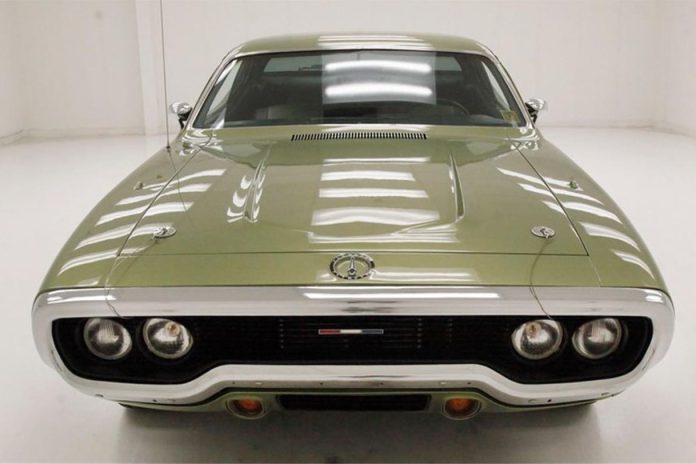Plymouth diverged from industry practice in 1971 by introducing a new idea: the new Satellite two-door hardtop was designed to be a personal two-door hardtop, not just a chopped-down version of the four-door. The result was unique styling and a wheelbase two-inches shorter than the four-door. Our Pick of the Day, a 1971 Plymouth Satellite Sebring, demonstrates the direction the brand was heading in the 1970s. It is listed on ClassicCars.com by a dealership in Morgantown, Pennsylvania. (Click the link to view the listing)

The Satellite name has its origins in a show car from the early 1960s. In 1965, with Plymouth marketing its B-body as a mid-size series, the Satellite became the top model, situated above the new Belvedere I and Belvedere II. Starting with the 1968 redesign, the numbered method was discontinued, and Plymouth’s mainstream mid-size cars became Belvedere, Satellite, and Sport Satellite, plus the Road Runner and GTX for performance fans. This naming structure continued through 1970.

With the 1971 redesign, Plymouth adjusted its naming structure once again. However, this was more than just a reshuffling because Plymouth spun off the coupe from the sedan, creating a distinct model all its own. When Dodge did the same thing, it relegated the Coronet nameplate to the four-doors, but all two-doors became Chargers, expanding the sporty coupe’s lineage. Plymouth did a similar thing, but the new coupe maintained the Satellite name.

The Plymouth two-doors started with the Satellite coupe, which had fixed rear quarter windows despite not having a B-pillar. It even had a standard rubber floor covering. Satellite Sebring was a step up from the Satellite coupe and featured a carpet and rear quarter windows that rolled down, plus other additions to trim and interior specs. New for 1971, replacing the Sport Satellite, was the Satellite Sebring Plus, which featured a standard V8 (in this case, a 318 two-barrel) and wood-grained Rallye instrument cluster with full set of gauges, vinyl buckets with integral head restraints, Deluxe wheel covers, black grille, and more fancy stuff. For all models, the 300-horsepower 383 was the top engine; anyone who wanted more power had to move up to the Road Runner or GTX.

By 1974, the Satellite lineup had been trimmed, losing the Sebring Plus and GTX, but the 1975 redesign ditched the Satellite name and Plymouth’s mid-size series (including four-doors) were called Fury (aside of the Road Runner), with the full-size cars becoming Gran Fury. Confusing, eh?

Satellites of any stripe for 1971 don’t often get love, but their sharp styling should be attracting more collectors. This Amber Sherwood metallic (GF3) 1971 Plymouth Satellite Sebring has been “carefully resprayed,” with the seller claiming, “Slight surface rust is noted on an otherwise clean undercoated and patina’d frame and floor panels, as well as underside of rockers.” Features include new bumpers, hood pins, luggage rack, and LEDs for the parking and taillights. American Racing Torq Thrust are wrapped in Hankook rubber.

Power comes from a 318 two-barrel with an upgraded dual exhaust system with Flowmasters. “This is a correct, but not original, remanufactured engine from ATK,” says the seller. The transmission is the trusty A904 TorqueFlite automatic. Adds the seller, “This mill has been treated to a new water pump, fresh tune up, new alternator and voltage regulator, new high-torque starter, new oil pump, new fuel pump and filter, and new Champion three-row aluminum radiator.

Interior features a (surprise!) two-tone green split front bench, with amenities that include a modern AH/FM/Bluetooth stereo, aftermarket gauges under the dash, 3-spoke steering wheel, aftermarket air conditioning, and even a vintage CB radio telephone!
Drive this 1971 Satellite Sebring as-is or make it what it could be. It has the bones to do whatever you decide, and you don’t have to worry about pedigree like you may with a Road Runner or GTX. Go have some fun for $24,900 and tell us about it!
Click here for this ClassicCars.com Pick of the Day.





